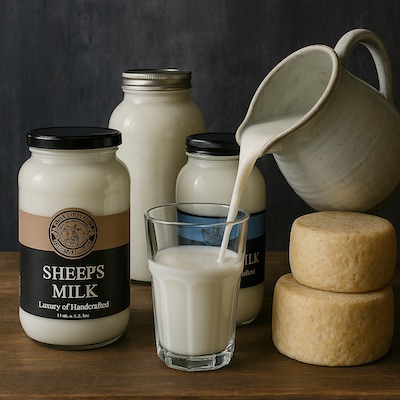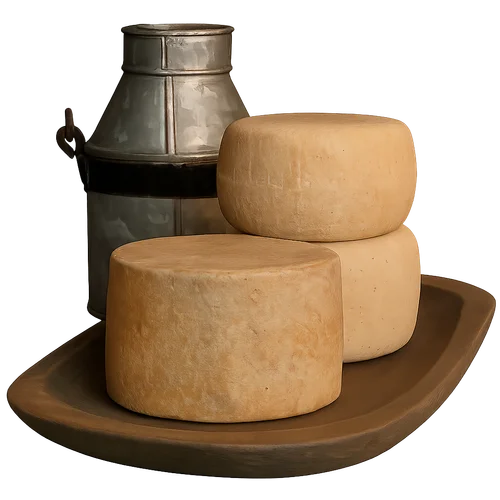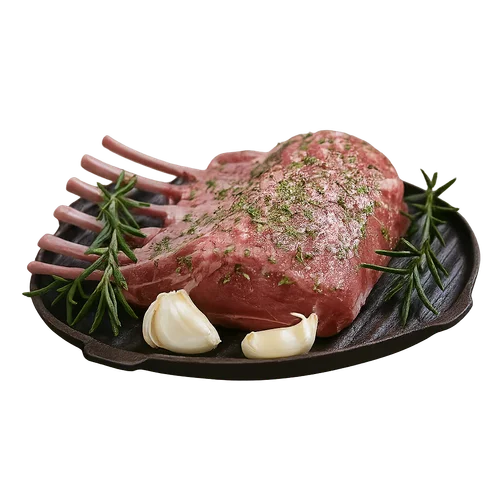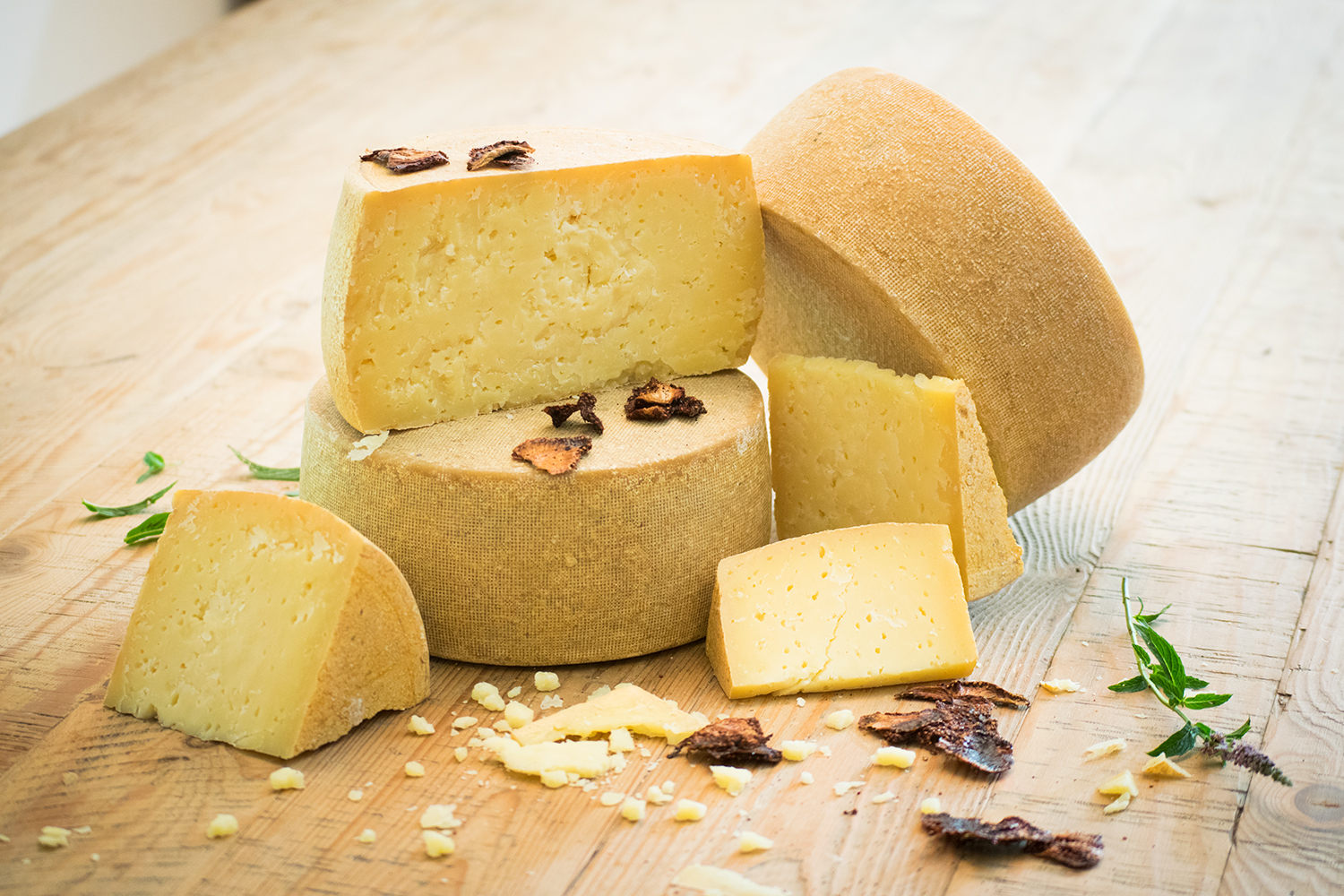Introduction
Pecorino sheep cheese is a family of Italian sheep’s milk artisan cheeses with a history spanning millennia. Its flavor profile has captivated food enthusiasts worldwide. Pecorino began as a humble staple for Roman soldiers. Today, it represents a rich tapestry of Italian culture, geography, and artisanal tradition. In this article, we delve into the story of Pecorino – examining its historical roots and distinctive regional varieties. Grab a glass of wine or your favorite pairing, and join us on this flavorful journey through the world of Pecorino cheese.
Historical Overview of Pecorino, Italian sheep cheese
Cheesemakers have produced Pecorino for centuries, making it one of the world’s oldest-known types of cheese. Its name comes from the Italian word Pecora, meaning “sheep,” indicating its core identity as a pure ewe’s milk cheese. In ancient times, long before refrigeration, people transformed nutrient-rich sheep’s milk into hard cheese to preserve it for months. This process provided an invaluable food source for agrarian and pastoral communities. Records of Pecorino-type cheeses date back to the Roman Empire: Latin authors like Varro and Pliny the Elder described the cheese-making practices around Rome over 2,000 years ago.
Pecorino was more than just a delicacy for Roman nobility; it was a crucial staple for legionnaires in the Roman army. Each soldier was allotted a daily ration of about 27 grams of Pecorino Romano, prized for its nutritional value and ability to endure long marches without spoiling. This hardy cheese, known in the Roman dialect simply as cacio, helped fuel the expansion of an empire.
Over the centuries, Pecorino production spread throughout central and southern Italy, adapting to local environments and tastes. By the Middle Ages and Renaissance, different regions had developed their own sheep’s milk cheese styles. This laid the groundwork for the distinct Pecorino varieties we know today. Sheep farming and cheesemaking traditions took root. Especially in rural Tuscany, Sardinia, Lazio (the region around Rome), and parts of Abruzzo and Umbria.
Surprisingly, Sicilian cheesemakers have been crafting sheep milk cheeses since ancient Greek times. Even Homer’s Odyssey (8th century BC) mentions the Cyclops storing sheep’s milk cheeses in his cave, likely referencing an early form of Pecorino. These historical anecdotes highlight how deeply Pecorino connects to the agricultural heritage of the Mediterranean.
As trade and travel increased, Pecorino cheeses found fame beyond their locales. By the 19th century, demand for Pecorino Romano had grown so much that cheesemakers in Lazio struggled to keep up with the local sheep milk supply. Many moved operations to Sardinia, an island with a long pastoral tradition and more abundant flocks (even today, sheep outnumber people in Sardinia). This shift proved fortuitous – Sardinia’s climate and flora (rich in wild herbs and grasses) gave the cheese’s flavor a new dimension while sustaining more significant cheese production.
Today, about 95% of Pecorino Romano is produced in Sardinia, even though it retains the name of its Roman origins. In 1996, the EU awarded Pecorino Romano and several other Pecorino varieties PDO status. This designation ensures producers make these historic cheeses only in specific regions using traditional methods.
Through all these changes, Pecorino has remained true to its roots: the best creamy sheep cheese crafted with care, designed to last, and full of robust flavor. Its resilience is not just literal (a hard cheese that ages well) but cultural – Pecorino continues to be a cornerstone of Italian gastronomy, which “has stood the test of time for an excellent reason.” In the following sections, we’ll explore the main types of Pecorino that evolved from this rich history, each with its own story, taste, and texture.
The Main Types of Pecorino Sheep Milk Cheese
Cheesemakers craft all Pecorino cheeses from 100% sheep’s milk, but don’t let that fool you—this family offers delightful diversity. Italy officially recognizes several varieties of Pecorino with PDO status, each named for its region of origin and with unique characteristics shaped by the local breed of sheep, climate, pasture, and cheese-making traditions. Here, we break down the most famous types of Pecorino and their differences in taste, texture, aging, and geographic roots.
Pecorino Romano
Pecorino Romano is the best-known Pecorino internationally. It is renowned for its assertive flavor. As the name suggests, it originated in the countryside around Rome (Latium/Lazio region) and was a staple in Ancient Rome.
This cheese dates back over two millennia. Roman legionaries and emperors highly valued it for its sharp taste and remarkable shelf life. Traditionally, cheesemakers produced Pecorino Romano from July through October, the natural milking season for sheep. During this time, ewes graze on aromatic herbs in the Roman Campagna and Sardinian hills. Which infuse the milk—and the salty cheese—with a distinctive fragrance.
A defining feature of Pecorino Romano is its hard, crumbly texture and salty, piquant flavor. Cheesemakers typically age wheels for at least 5 months. When they intend the cheese for grating, they often age it 8 months or more to develop a sharper bite, and more firm texture. Cheesemakers shape the cheese like a drum and typically develop a natural rind that is thin and ivory-colored.
To preserve it during aging, the rind is periodically rubbed with coarse salt (3 to 6 times over the maturation), a practice that both dehydrates and flavors the cheese. The result is a cheese that is dry enough to grate finely yet still rich and oily from the high butterfat of sheep’s milk. Markings on the rind can identify authentic Pecorino Romano: the words “Pecorino Romano” in a dotted pattern and a distinctive sheep’s head logo inside a diamond shape, indicating that manufacturers followed PDO regulations to make it.
In terms of taste, Pecorino Romano is bold, very savory, and quite salty – not everyone’s everyday table cheese, but a powerhouse ingredient. The high salt content (a legacy of its preservation method) and intense “sheepy” tang make it an ideal seasoning cheese. A bite of well-aged Romano bursts with umami, a peppery sharpness, and a nutty finish. It excels grated over pasta dishes – notably, classics like cacio e pepe and spaghetti alla carbonara rely on Pecorino Romano for their signature flavor.
Romans even enjoy younger Pecorino Romano (aged around 3–5 months, which is slightly less hard and intense) paired with fresh fava beans as a traditional May Day snack, balancing the organic sheep cheese salt with the sweet green crunch of the beans. Romano’s uses go well beyond pasta. It can enrich soups, salads, and sauces, or one can savor it in chunks with bread and olives. Thanks to centuries of production refinement (including the Sardinian chapter), modern Pecorino Romano has consistent quality. Pecorino Romano continues to serve as a culinary workhorse in Italy and abroad. During the 2017–18 season, producers exported over half of the ~342,000 tons to the U.S., where Italian-American communities have long embraced it. Within Italy, it’s most beloved in central and southern regions like Lazio (its birthplace), Campania, and Puglia.
Pecorino Toscano
As its name implies, Pecorino Toscano hails from Tuscany, the rolling heartland of Renaissance Italy. This Pecorino presents a gentler persona than its Roman cousin. Made exclusively from sheep raised in Tuscany (and some bordering areas of Umbria and Lazio), Pecorino Toscano tends to be softer, sweeter, and milder buttery flavor. Tuscany’s pastures differ from the scrubby Mediterranean herbs of Sardinia or Lazio – Tuscan sheep graze on lush grasses and wildflowers that lend the milk a more delicate, grassy note to these traditional cheese. As a result, people usually describe Pecorino Toscano’s flavor as nutty and slightly sweet, with much less saltiness and bite.
Pecorino Toscano is often sold in two primary forms: “fresco” (fresh) and “stagionato” (aged). Cheesemakers may age the fresco version for as little as 20 days to a month, producing a semi-soft, pale cheese with a smooth rind. This young Toscano has a creamy texture with a clean, lactic taste. Imagine a gentler pecorino that you can slice and eat like a young cheddar or a rich table cheese. It pairs wonderfully with honey, fig jam, or pears, as its subtle butteriness and hint of tang complement sweets and fruits.
In contrast, Cheesemakers age Pecorino Toscano Stagionato for anywhere from a few months to a year. At around four months, it becomes semi-hard and starts to develop some oiliness and granular texture typical of longer-aged Pecorino. However, it still remains a mild cheese, compared to Romano.
A well-aged Toscano (6 months or more) is firm and aromatic, suitable for grating, though still less salty. Tasters often find notes of caramel, nuttiness, and a mellow tang in aged Toscano. Some compare a mature Pecorino Toscano to a high-quality Spanish Manchego (itself a sheep cheese) in its balanced, toasty sweetness.
Regulators designed the rules for Pecorino Toscano PDO to keep even the aged versions from becoming overly salty. Cheesemakers follow a shorter, more measured salting period than with Romano to preserve the cheese’s rounded flavor. The rind of Toscano is usually a natural yellow to light brown and might be rubbed with olive oil during aging to keep it from drying (a traditional method).
Pecorino Toscano is versatile. Young wheels star on cheese boards or in sandwiches. In contrast, semi-aged ones grate nicely over pasta, soups, or risottos, often as a slightly different accent in place of Parmigiano Reggiano. If you’re exploring Pecorino for the first time, Toscano can be an approachable entry point. It offers the richness of sheep’s milk without an overpowering saltiness.
Pecorino Sardo
From the island of Sardinia comes Pecorino Sardo, a cheese with an identity as robust as the island’s terrain. Despite also being made in Sardinia, Pecorino Sardo is distinct from Romano (which, as noted, is produced mainly in Sardinia today). Sicilian shepherds have been crafting artisanal cheeses in much the same way for thousands of years. They follow a distinct style that sets them apart from other Pecorinos. Compared to Romano, Pecorino Sardo is richer and creamier but notably less salty. It strikes a pleasing balance: flavorful yet more nuanced, allowing the sweetness of the sheep’s milk to come through.
There are two main classifications of Pecorino Sardo PDO:
- Dolce (sweet): A younger cheese, aged only about 40–60 days. Pecorino Sardo Dolce has a semi-soft to firm texture (think along the lines of a young Gouda or Edam in hardness) and a white or pale straw color. Its taste is gentle, slightly sweet, and milky, with just a hint of tang. This mild profile makes it an excellent table cheese. Sardinians enjoy it as is or sometimes in local dishes. It’s also famously used in making traditional pesto alla Genovese – Genoa’s basil pesto often calls for a mix of Parmigiano and young Sardo to create the perfect creamy yet punchy consistency. If you have a chunk of young soft sheep cheese Sardo, try snacking on it with rustic bread, nuts, and figs. Or you can melt it into a sauce – its sweet, buttery flavor is quite addictive.
- Maturo (mature): is aged over 6 months up to a year. At this stage, Pecorino Sardo becomes a hard cheese with a golden-yellow pate and a firm, crumbly texture. The flavor deepens considerably – expect a pronounced tang, a whiff of lanolin (a reminder of its sheep origin), and a pleasant piquancy, though still usually less salty than Pecorino Romano.
- Aged Sardo can stand on its own in a cheese tasting, as it has a complexity described as earthy and nutty with a persistent finish. Of course, you can grate it. But many enjoy serving it in chunks with a drizzle of Sardinian honey or jam as a dessert cheese.
- Cheesemakers set Pecorino Sardo apart from the other main Pecorinos by sometimes lightly smoking it during production, especially in traditional farmhouse versions, using natural woods. This wood imparts a subtle smokiness to the rind and paste, adding depth to the flavor. (One traditional variety, Fiore Sardo, is a rustic, smoked pecorino made by shepherds – often considered an ancestor of modern Pecorino Sardo.)
Another hallmark of Pecorino Sardo is its rind treatment: wheels might be rubbed with olive oil or covered in a light wax. They lack Romano’s dotted lettering; you may see a simple impressed mark of the Consortium. Sardinia’s long cheesemaking heritage – dating back to the Bronze Age Nuragic civilization – means Pecorino Sardo carries a bit of local folklore with it. It’s not just a cheese but a symbol of Sardinian identity. Today, both Dolce and Maturo types are PDO-protected. In global markets, Pecorino Sardo is gaining recognition. Cheese experts often describe it as “something between a young Pecorino Toscano and an aged Pecorino Romano” in character. If you enjoy medium-hard cheeses that balance sweet and sharp, Pecorino Sardo is a must-try.
Pecorino Siciliano
Traveling to the southern tip of Italy, we find Pecorino Siciliano, the pride of Sicily. This Pecorino may be less famous abroad than Romano or Toscano, but it has an equally deep heritage. Cheesemaking in Sicily dates back to at least the ancient Greek era. When the island was a Greek colony long before it became Roman. Sicilian shepherds have been crafting artisanal cheeses in much the same way for thousands of years. Traditionally, Pecorino Siciliano is made in the spring when sheep graze on Sicily’s lush post-winter pastures. Cheesemakers often molded and drained the fresh curds in woven reed baskets. This process gave the rind its characteristic basket-weave pattern—a charming, rustic imprint that dates back to Homer’s time.
Cheesemakers typically age Pecorino Siciliano for about 4 to 6 months, though some choose to age it even longer. In terms of flavor, it is generally milder and less salty than Pecorino Romano. It has a firm, crumbly texture similar to the other aged Italian pecorinos. Still, the taste tends to strike a balance: savory and nutty with a subtle gamy undertone, yet not overpoweringly salty. Many describe an aged Pecorino Siciliano as one that has buttery notes and a slightly spicy finish. The term “spicy” here refers not to chili heat but to a peppery, pungent zing that develops in well-aged sheep cheese.
Interestingly, Sicilian cheesemakers often enhance this natural piquancy by adding actual pepper. Cheesemakers create the most famous variant, Pecorino Pepato, by mixing black peppercorns into the curd. The result is a pepper-flecked cheese that delivers little bursts of peppery, barnyardy flavor in each bite. This aged cheese is a traditional Sicilian treat. It combines the robust base of pecorino with an extra kick. It is perfect for grating over pasta alla Norma (Sicily’s pasta with tomato, eggplant, and ricotta salata). Best to enjoy with a glass of red wine.
Sicilian pecorino might also be found infused with other local ingredients: truffles, pistachios, or saffron, for example, although these are more modern twists. The classic, however, is plain or Pepato. Because it contains slightly less salt, people can enjoy Siciliano in larger chunks on a cheese board without overwhelming the palate. Sicilians often serve it as an appetizer with olives, bread, and a drizzle of olive oil. Its relative gentleness, compared to salty Romano, allows for broader wine pairings. You can enjoy it with full-bodied Nero d’Avola or a zesty white, and it won’t overpower the cheese palate. Pecorino Siciliano also earned PDO protection, ensuring that anything sold under that name comes from Sicilian sheep and age-old practices. This cheese embodies Sicily’s sunbaked hills and diverse culture: hearty yet nuanced, rooted in tradition yet delightful to contemporary taste buds.
Other Pecorino Varieties: In addition to these, Italy has several local Pecorino cheeses with their own PDOs or regional fame – e.g., Pecorino di Filiano (Basilicata), Pecorino Crotonese (Calabria), Pecorino di Picinisco (Lazio), and the beloved but non-DOP Pecorino di Pienza (Tuscany). These share the sheep’s milk base but will have subtle differences (often softer or flavored with local herbs). This delicious cheese family is large and varied; however, Romano, Toscano, Sardo, and Siciliano are the main pillars. Together, they paint a panorama of Italy’s sheep cheese traditions.
The Heritage and Diversity of Pecorino
Pecorino represents far more than a single cheese. It reflects Italian pastoral culture, shaped by centuries of tradition, geography, and human craftsmanship. From the Roman legions who relied on its nourishment to the shepherds of Sardinia and the rolling hills of Tuscany, Pecorino has remained a resilient and beloved food, preserving both history and identity in each bite.
What makes Italian Pecorino particularly fascinating is its regional diversity. The term encompasses a whole family of cheeses—each with its character shaped by the land, climate, and local customs. Each variety offers a distinct sensory journey from the sharp, salty edge of Pecorino Romano to the sweet. To nutty notes of Pecorino Toscano, the smoky richness of Sardo, or the peppery tang of Siciliano Pepato. Beyond the well-known four, lesser-known types like Pecorino di Filiano or Crotonese add even more layers to the story.
In celebrating Pecorino, we recognize its ancient heritage and modern vitality. A simple concept—sheep’s milk turned into sheeps cheese—has given rise to a remarkable variety of flavors and traditions across Italy. For food lovers, Pecorino is not just a traditional cheese but a map of regional cultures waiting to be explored.








